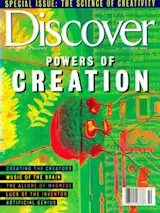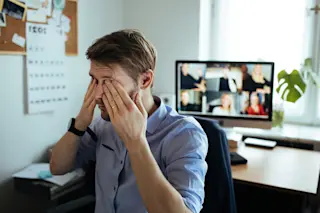Fifty-five years ago, on a brisk March morning, the novelist Virginia Woolf walked from her country house at Rodmell, in Sussex, England, to the banks of the nearby River Ouse. There she lay down her walking stick and picked up a large stone, forcing it into the pocket of her coat. Then she walked on. The stone did the trick; it was three weeks before her body surfaced on the far shore.
To Leonard, her husband, she had left a note propped on the mantelpiece. Dearest, it read, I feel certain I am going mad again . . . and I shan’t recover this time. I begin to hear voices, and I can’t concentrate. . . . I don’t think two people could have been happier till this terrible disease came. . . . V.
The diary Woolf kept from 1915 until four days before her suicide suggests that her terrible disease may have been manic depression, now also known as bipolar illness. This condition, classed by psychiatrists as a mood disorder, involves a series of emotional peaks and valleys that over time often become higher, lower, and closer together. Some sufferers experience deep depressions and moderate manic episodes; others have moderate, short-lived depressions but become so manic they begin to hallucinate.
Woolf’s depressive episodes were cyclic--sometimes seasonal, sometimes connected with finishing a book. Yet in between her depressions and episodes of outright mania, she managed to be highly productive and was often lively and charming. I always felt on leaving her that I had drunk two glasses of excellent champagne, her friend Nigel Nicolson has recalled. She was a life enhancer.
If accurate, the diagnosis of bipolar disease puts Woolf in impressive company. It’s not just that she is thereby entitled to join the ranks of mad artists who have always figured in the popular image of creativity. Bipolar illness elevates her to a more elite group. Over the past two decades a swelling chorus of psychologists, psychiatrists, and even a few neuroscientists have begun to suggest that bipolar illness somehow enhances the ability to make art. This mysterious and still hypothetical link, they say, may account for the persistence of the more generalized hoary stereotype.
Even the most ardent advocates of the connection concede that most creativity has nothing to do with mental illness and that most of the mentally ill, bipolar or otherwise, are no more creative than the rest of us. Yet it must be more than coincidence, they say, that the life and work histories of so many giants of Western culture show patterns reminiscent of bipolar illness.
Johns Hopkins University psychologist Kay Redfield Jamison, whose many books and articles on the subject have made her the de facto point person for the art-and-madness link, has compiled a roll call of the artists in this unhappy club that reads like the A-list for the cocktail party of the millennium. Among them are poets William Blake, John Keats, Percy Bysshe Shelley, Edgar Allan Poe, Emily Dickinson, and Anne Sexton; novelists Emile Zola, Mary Shelley, Leo Tolstoy, Maxim Gorky, and Robert Louis Stevenson; playwright Eugene O’Neill; visual artists Michelangelo, Théodore Géricault, Edvard Munch, Paul Gaugin, Vincent van Gogh, Mark Rothko, and Georgia O’Keeffe; and musicians from Handel to Charlie Parker. She includes, in fact, practically every famously tormented artist in the canon.
The very inclusiveness of this list, however, has raised a few eyebrows. Skeptics charge that giving dead artists retroactive psychiatric diagnoses, then treating those diagnoses as evidence, is a parlor game, not science. There’s a long tradition regarding inspiration as divine, says psychiatrist Frank Johnson of the University of California at San Francisco, who until his retirement two years ago participated in a program treating artists for their psychological and physical problems. The more modern, technological version of this in the medical literature makes madness the condition for writing poetry or doing philosophy.
Furthermore, as critics like Johnson point out, bipolar illness is only the latest in a list of organic conditions correlated with creativity. In the 1960s, for example, alcoholism was the literary disease of choice; earlier in the century epilepsy and syphilitic paresis were linked to genius. Is it possible, as Susan Sontag observed in Illness as Metaphor, that insanity is merely the current vehicle of our secular myth of self-transcendence?
Critics of the self-transcendence myth point out that the gifts of many of the same artists who are now postmortem draftees to the bipolar ranks--Keats, Shelley, Poe, Gorky, Stevenson, and O’Neill, among others-- were once routinely attributed not to mental illness but to the mysterious and often fatal physical illness tuberculosis. Like manic depression, tb involved alternating periods of hyperactivity and lassitude; it, too, was thought to create a mental exaltation that predisposed its victims to extraordinary insights. So widespread was the belief in this association that one turn-of-the-century critic attributed the perceived decline in quality of literature and the arts to the gradual disappearance of consumption.
There is another objection--less subtle but perhaps more heartfelt than any of the academic cavils--raised by people who have experienced bipolar illness firsthand. They point out that between 10 and 15 percent of people with severe forms of the illness eventually take their own life. Even if there is a link between art and madness in some small and unquantifiable subset of creative people, so what? The push to emphasize this link, they feel, glamorizes a killer, sugarcoats its destructiveness, and makes life even harder for ordinary people trying desperately to stay on an even keel. It’s bad enough to be sick, says Laura M., who has had bipolar disease for 15 years, attempted suicide twice, and is currently running several bipolar support groups. Why should we have to deal with people expecting us to be creative? Adds Katherine T., a fellow sufferer and group member who, through medication, manages to function successfully as a potter and painter, I hate for people to admire the creativity and support an illness that ends in something so criminal to the self as suicide.
The notion of a link between creative genius and madness has had a long, if checkered, history in Western thought. Plato believed that poetry untouched by the madness of the Muses was always eclipsed by the performances of the inspired madman. And Aristotle wondered, Why is it that all men who are outstanding in philosophy, poetry, or the arts are melancholic?
Ancient Greek opinion shaped popular Western attitudes until the eighteenth century, when tranquillity briefly superseded angst as the supposed wellspring of inspiration. A painter ought to have a Sweet, and Happy Turn of Mind, wrote essayist Jonathan Richardson in 1715, that Great and Lovely Ideas may have a Reception there. It is impossible to imagine a mad Shakespeare, commented Charles Lamb 111 years later, in an apostrophe to the necessary partnership of genius and sanity. (Like many people interested in the subject, Lamb wrote from personal experience: his sister and literary collaborator, Mary, stabbed their mother to death during a manic episode, and Charles himself spent time in a madhouse.) But Lamb was out of step with his time. With nineteenth-century poets Byron, Shelley, and Coleridge--Lamb’s contemporaries--Western culture was gripped anew by the image of the wild-eyed, suffering artist who was channeling some power greater than himself.
More recently, works such as R. D. Laing’s 1960s campus classic The Politics of Experience suggested that schizophrenics create some of the truest art because the mad are more closely in touch with their inner selves than are the sane. In retrospect, this conclusion seems like the triumph of politics over rationality; contemporary schizophrenia researchers are more impressed by the destructiveness of the disease than its creative fecundity.
Why should the idea of a link between art and madness have such a hold on the popular imagination? Some clinicians attribute it to a rather unpleasant human trait: extraordinary accomplishments, they say, make the rest of us nervous. We have only two ways to react to creative people in this culture, says Harvard psychiatrist Albert Rothenberg. We either worship them or we’re jealous.
We do this with athletes as well as artists, adds Johnson. We call their skills ‘uncanny,’ which is a backhanded pathologizing of achievement, instead of crediting perseverance.
According to Johnson’s view, an observation like Baudelaire’s lofty I have felt the wind of the wing of madness is comforting; it provides us a little frisson, then allows us to settle back and fish between the sofa cushions for the remote. No need to make the effort to create a poem or anything else; art is the province of the mad.
But there may be a simpler reason that the question seems to intrigue each generation anew: the data that might resolve it are so hard to obtain. If researchers look to the great artists of the past for answers, a standoff is inevitable. Both sides have their lists. Does a cheerful Jane Austen trump a melancholy Virginia Woolf? Does the businesslike, bourgeois Anthony Trollope outrank the hard-drinking, depressive Ernest Hemingway? Was Mark Rothko, who cut open the arteries of his arms, somehow a more real artist than Pierre-Auguste Renoir, who died peacefully in bed?
And studying living artists isn’t any easier. Some researchers have elected to approach people who have been socially defined as creative- -recipients of prizes, for instance--and tried to assess their mental health. But these artists may not be representative of the art world as a whole: many avant-garde writers and painters never make it into the canon. And this strategy may not achieve an accurate sample of even these mainstream geniuses. Subjects may refuse to participate because of the stigma of mental illness. Depression is sort of respectable, says Kay Jamison, acknowledging the problem, but mania isn’t. If you’re manic, you’re really crazy.
Nevertheless, the two studies that effectively launched the revival of interest in the question opted for this approach. In 1974, while doing a residency in psychiatry at the University of Iowa, Nancy Andreasen began looking to test the then current idea of a link between schizophrenia and creativity. Andreasen, a Ph.D. in English literature, initiated interviews with 30 faculty members at the prestigious University of Iowa Writers’ Workshop and matched the faculty members with control subjects in nonartistic professions. She found that 80 percent of the participating writers revealed they had suffered either depression or manic depression, compared with 30 percent of the control subjects. (Two of the writers eventually took their own lives.) The bipolar connection, she recalls, just leaped out at me.
But when the results of her work were published in 1987, the connection didn’t leap out at everyone. Rothenberg objects to her control group, which he says was not really comparable with the group of creative people, and points out that Andreasen herself did the interviews and made the diagnoses, with none of the customary cross-checking to ensure objectivity. Rothenberg himself has spent 30 years interviewing eminent creative people--Nobel and Pulitzer Prize winners among them--and is convinced that creativity is facilitated by mental health, not illness. Andreasen, however, is as firm in her beliefs as Rothenberg is in his. The link between bipolar illness and creativity is genuine and extremely robust, she maintains.
Kay Redfield Jamison’s first work on the subject, a 1989 study of mood disorders among creative people, gained even more public attention than Andreasen’s. While on a sabbatical at Oxford, Jamison had approached a large group of eminent Britons and asked them to complete exhaustive questionnaires about mood swings and creativity. Her eventual sample included only the heaviest of cultural heavy hitters: members of the Royal Academy, Booker Prize winners, contributors to The Oxford Book of Twentieth-Century English Verse.
What she found was psychic distress in spades. In the general population, rates of bipolar illness hover at about 1 percent, and major depression affects between 5 and 15 percent of the population. In Jamison’s sample, however, 38 percent of the artists had been treated for affective illness (including simple depression as well as bipolar illness), and for three-quarters of that group the treatment had gone beyond talk therapy to lithium, antidepressants, electroshock, or all three. Clearly, intense emotional pain went hand in hand with creativity for even the most successful of these artists.
Jamison admits that the number of artists in each category was small--eight novelists, for instance, and eight playwrights--but still thinks the results are telling. Of course our studies have methodological problems, she says. But they all point to the same association. So you have to ask yourself: Is there a trend? Is the trend in the same direction? And if the answer is yes, then you at least have to entertain the possibility that the studies are right.
The largest study done to date does seem to confirm the association found by Andreasen and Jamison. The subtitle of Arnold Ludwig’s book The Price of Greatness says it all: Resolving the Creativity and Madness Controversy. For a decade Ludwig and his research associates have been sifting through upwards of 2,200 biographies of 1,004 eminent men and women in an effort to learn what factors combine to produce the kind of high-order creativity that makes historians sit up and take notice.
By using secondary sources, Ludwig avoids some of the sampling problems for which Jamison and Andreasen were criticized. And he has an answer to the objection that biographies have biases of their own. On the whole, I think biographers--who spend years getting to know their subjects- -will have a better perspective than a clinician asking standardized questions or administering a questionnaire, which has built-in theoretical or diagnostic assumptions, he says. After all, what you get in a clinical interview is autobiography, and that’s the most inaccurate record of all.
Ludwig found that, as a group, creative artists displayed much higher levels of mental illness than did their creative counterparts in more structured occupations. As adolescents, between 29 and 34 percent of eminent-artists-to-be exhibited psychiatric symptoms--ranging from hypochondria and moody and introspective fits all the way to psychotic hallucinations and suicide attempts--compared with 3 to 9 percent of future achievers in the sciences, sports, and business. (The precise percentage depends on the strictness of diagnostic criteria.) The differences among adults are equally striking, with rates of between 70 and 77 percent for poets, musical performers, and fiction writers; 59 to 68 percent for painters, composers, and nonfiction writers; and only 18 to 29 percent for eminent natural scientists, politicians, architects, and businesspeople.
Ludwig differs from Jamison and Andreasen in the significance he attaches to that finding. Andreasen and Jamison argue that bipolar illness enhances artistic vision, while Ludwig’s explanation is more prosaic. Creative people who are mentally ill find themselves, almost by default, he thinks, in the arts rather than in business or the sciences.
As Ludwig sees it, the reasons are self-evident. In the scientific world, advantageous traits include rationality, persistence, and levelheadedness, he says. You need to write grant proposals, do experiments, get along with people, show up for work. The alternating episodes of wild enthusiasm and paralyzing depression that can characterize bipolar illness would be fatal to scientific achievement, he says, but an artist might draw on them as a source of inspiration.
And for cultural reasons, an aspiring poet has little impetus to curb flamboyant behavior; in fact, a certain amount of drama is de rigueur. If a politician drinks or is depressed, says Ludwig, he or she will try to hide it. Look at what happened to Thomas Eagleton, for instance, when people found out he’d been hospitalized for depression. (Eagleton spent two weeks as the running mate of presidential candidate George McGovern in 1972, before being dropped from the ballot.) But when you hear that a poet drinks or has been mentally ill, you think, ‘So, what else is new?’
However, Ludwig doesn’t buy into the stereotype of the inspired artist, creating only when the mood is right. Anybody who achieves creative greatness is dedicated, he says. These people persevere; they’re almost monomanical. Think of Picasso, or Cézanne. In his view this dedication leads to the real price of greatness, which isn’t madness but the seemingly inevitable trail of domestic destruction. Work is paramount to great artists, and there’s a lot of family fallout, he says. You can’t fly that close to the sun without getting singed.
The real sticking point for any theory about a synergy between art and mental illness is explaining how the mechanism works. Some clinicians have concluded that all sorts of mental and physical problems-- from depression to severe childhood illness--confer outsider status, and that feeling outside the mainstream can help motivate people to become artists. It doesn’t necessarily have to be madness, says psychiatrist Bob Klitzman of Columbia University. You can feel like an outsider because you’re gay, or a woman, or a Southerner, or black. Anything that gives you the sense that the world you see isn’t the world that others see can motivate you to want to tell your own story.
Other explanations, while often appealing and intuitive, can be maddeningly vague. Even Ludwig’s straightforward, sociological explanation turns softer when he tries to pin down the intersection of creativity and madness. He invokes the idea of psychological unease, which he calls a kind of restlessness, discomfort, need to express oneself. Emotionally healthy creative people have it, and they attach it to a problem, he thinks; when the problem is solved, it motivates them to seek out a new problem to work on. The mentally ill have it, too, he says, but their unease is more pervasive and free-floating. They have, in his words, more trouble putting their psychological lids back on.
But the most visionary explanations are reserved for the creative processes of bipolar artists. I think bipolars are open to contradiction, they take risks, they defy order, says Andreasen. These are traits that make them both more vulnerable and more original than the rest of us.
And when Kay Jamison talks about the effects of bipolar disease, she sounds downright mystical. Jamison, who in 1995 revealed in her memoir An Unquiet Mind that she has been manic depressive since adolescence, describes a preternatural awareness of surroundings, a sensitivity to the environment that is more animal-like than human. Bipolar illness confers a great range and intensity to moods, she says, which can then be translated into art. You can’t predict what you’ll be like tomorrow. I think the moods of bipolarity mirror the natural world, which is so seasonal and fluid. It’s a dangerous, amphibious sort of existence.
Short of putting a poet in a brain scanner and instructing her to write a sonnet, it is difficult to imagine how creativity could be assessed in a culturally neutral way. Through functional neuroimaging techniques, researchers are in fact slowly beginning to understand what goes on in the brains of mood-disordered patients, but most of what they’ve learned has concerned the depressive end of the spectrum, for a purely practical reason: mania involves physical as well as mental restlessness. Someone in the middle of a manic episode is incapable of staying still long enough for a brain scan. Yet neuroscientists studying language in the brain have noticed a pattern that may help explain at least one element of bipolar creativity: verbal fluency.
Emil Kraepelin, the German psychiatrist who first described bipolar illness, remarked that his patients delighted in rhymes and puns, an observation that has been confirmed by other therapists and researchers. One of the official diagnostic criteria for mild mania, in fact, is rapidity of speech that may include jokes, puns, plays on words, and irrelevancies.
Cognitive neuroscientist Michael Posner and co-workers at the University of Oregon recently attached a large number of electrodes to volunteers’ scalps and measured the electrical activity in their brains as they performed two sets of word-association tasks. For the first test the subjects were asked merely to read a list of nouns, such as hammer and broom, and to come up with a prosaic use for each noun: something like pound for hammer and sweep for broom.
The straightforward word-generation tasks produced activation in the front and side of the left hemisphere. This isn’t news; neuroscientists have long understood those regions to be involved in language. But when subjects were asked to come up with a less usual association for each noun- -witch with broom, and throw with hammer--things changed. The electrical activity was coming from an area in the right parietal hemisphere--the mirror image of the one on the side of the left hemisphere.
Hints that some language skills lay in the right hemisphere had already emerged: right-hemisphere strokes can blunt sensitivity to words, making such stroke patients very literal, incapable of understanding metaphors or puns. While early hypotheses that mania is a right-hemisphere phenomenon and depression a left-hemisphere one have been discarded as too simplistic, clearly the right hemisphere is implicated in some kinds of mania. Certain epileptic seizures in the right hemisphere, for example, induce manic-like symptoms.
So is it at least possible that someone in a manic phase, by virtue of some disruption in right-hemisphere functioning, might have readier access to an area in the brain associated with wordplay? This might be a bit of a leap, says Posner. And it doesn’t explain how mania could affect activities, such as music, thought to involve the left hemisphere.
Such speculations leave defenders of creativity as a product of mental health unconvinced. Rothenberg continues to maintain that the essence of the creative process is the ability to hold several antithetical ideas in the mind at once, a task that demands robust mental health. The idea of a thin line between art and madness may make a good sound bite, he says, but the psychological processes are worlds apart.
Rothenberg’s ultimate objection is a philosophical one. To attribute creativity to mental illness is the worst sort of aesthetic reductionism, he thinks. The tragic worldview is just that, he says, It’s a way of seeing the world. To call it a symptom of depression is to trivialize it, to say, ‘I don’t have to take this seriously.’ He also suspects that linking art and madness is destructive to the mentally ill. If people think mental illness is somehow making them creative, he says, it gives them a reason not to try to get better.
Yet listening to the anguish of people struggling with bipolar illness, this last possibility seems remote. Sometimes I think God gave me the gift of creativity as a consolation prize, says support-group member Katherine T. in her small, drug-thickened voice, but I’m still suffering. I don’t know where this disease came from, but I sure wish it would go away.














